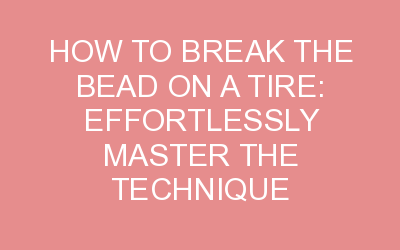To break the bead on a tire, use a bead breaker and apply even pressure around the edge of the tire. Breaking the bead on a tire is an essential skill for anyone in the automotive industry or DIY enthusiasts who want to change or repair tires.
By breaking the bead, you can easily remove the tire from the wheel for various purposes such as patching a puncture, replacing a damaged tire, or mounting a new one.
Although it may seem challenging, with a few simple steps and the right tools, breaking the bead on a tire can be a relatively straightforward process.
We will guide you through the steps on how to break the bead on a tire efficiently and safely, allowing you to tackle your tire-related tasks with confidence. Let’s get started!
Understanding The Bead Of A Tire
Understanding the bead of a tire is crucial for knowing how to break it. This process requires careful steps to ensure safety and efficiency when removing the tire from the rim.
The Composition And Purpose Of The Tire Bead
The bead of a tire is a critically important part that often goes unnoticed. It is located on the inner edge of the tire, and its primary purpose is to securely hold the tire onto the wheel rim. Understanding the composition and purpose of the tire bead is crucial when it comes to performing certain tire maintenance tasks.
The tire bead is made up of high-strength steel wires that are coated with rubber. These wires are tightly wound together and encased in a layer of rubber. This construction ensures that the bead is strong and flexible enough to withstand the forces exerted on the tire when it is inflated and in motion. The rubber coating on the bead provides a seal between the tire and the rim, preventing air leakage.
When the tire is mounted onto the wheel rim, the tire bead sits in a groove on the rim called the bead seat. This ensures a secure fit and prevents the tire from slipping or separating from the rim, even under extreme conditions. The bead seat is specially designed to match the shape and size of the tire bead for a precise fit.
Why It’s Important To Break The Bead For Certain Tire Maintenance Tasks
Breaking the bead is a process of separating the tire bead from the rim, which is necessary for various tire maintenance tasks. By doing so, you gain access to the inner part of the tire, allowing you to perform repairs, replace the tire valve, or change the tire altogether.
Here are some important reasons why breaking the bead is crucial for certain tire maintenance tasks:
1. Tire Patching or Repair: When a tire gets punctured, it often requires patching or repair to restore its integrity. Breaking the bead allows you to inspect the inner surface of the tire for damage and apply a patch or perform a repair in a controlled and thorough manner. It ensures that the patch or repair is properly applied and provides a long-lasting solution.
2. Tire Valve Replacement: The valve stem is responsible for maintaining proper air pressure in the tire. Over time, valve stems can wear out or become damaged. To replace a tire valve, it is necessary to break the bead so that you can access the inner part of the tire and remove the old valve. Installing a new valve is then a straightforward process before reseating the tire.
3. Tire Replacement: Eventually, all tires wear out and need to be replaced. Breaking the bead is essential for removing the old tire from the rim and installing a new one. It allows for a smooth and safe tire replacement process, ensuring that the new tire is properly seated and aligned on the rim before reinflating it.
It is important to note that breaking the bead should only be done by experienced individuals who have the necessary tools and knowledge. Mishandling this process can cause damage to the tire or rim, compromise safety, or lead to an improper tire fit.
Tools And Equipment Needed
Step-by-step Guide To Breaking The Bead
Breaking the bead on a tire is an essential skill for any car enthusiast or mechanic. This process involves separating the tire from the wheel, making it easier to repair or replace. By following a step-by-step guide, you can safely and effectively break the bead without causing damage to the tire or wheel.
Preparing The Tire And Vehicle For The Bead-breaking Process
Before attempting to break the bead, it’s crucial to properly prepare both the tire and the vehicle. Here are the necessary steps to take:
- Step 1: Position the vehicle – Park the vehicle on a flat and stable surface. Engage the parking brake to prevent any movement during the process.
- Step 2: Deflate the tire – Using a tire pressure gauge, release the air from the tire until it is completely deflated. This step ensures that the tire is more flexible and easier to manipulate during the bead-breaking process.
- Step 3: Remove the wheel from the vehicle – Depending on the type of vehicle, you may need to remove the entire wheel or just the affected tire. Refer to your vehicle’s manual for guidance on proper wheel removal.
Techniques For Safely Breaking The Bead Using The Tools Mentioned Earlier
Once the tire and vehicle are properly prepared, you can move on to breaking the bead using the appropriate tools. Here are some techniques to consider:
- Step 4: Position the wheel and tire – Place the wheel on a stable surface with the tire facing upwards. Ensure that the wheel is well-secured to prevent any unnecessary movement during the process.
- Step 5: Apply lubricant – Using a bead-breaking lubricant, generously apply it to the outer rim of the wheel and the inside of the tire bead. This lubricant helps to reduce friction and ease the bead-breaking process.
- Step 6: Use a bead breaker tool – With the wheel and tire in position, use a bead breaker tool such as a tire iron or a specialized bead breaker tool. Insert the tool between the tire bead and the wheel rim, applying steady and even pressure to break the bead free.
Tips To Prevent Damage To The Tire Or Wheel During The Process
Although the bead-breaking process is relatively straightforward, there are a few tips to keep in mind to prevent any damage to the tire or wheel:
- Tip 1: Apply consistent pressure – When using a bead breaker tool, apply steady and even pressure as excessive force can damage the tire or wheel.
- Tip 2: Double-check the lubrication – Ensure that the lubricant is thoroughly applied to both the tire bead and the wheel rim, reducing the risk of unnecessary friction.
- Tip 3: Inspect for damage – After breaking the bead, inspect both the tire and wheel for any signs of damage. If any issues are found, consult a professional for further evaluation and repair.
By following this step-by-step guide and keeping these tips in mind, you can successfully break the bead on a tire without causing any damage. Remember to exercise caution throughout the process and prioritize safety at all times.
Troubleshooting And Common Mistakes
Breaking the bead on a tire can be a challenging task, especially for those who are new to it. Along the way, there are potential challenges and common mistakes that may arise. In this section, we will explore these issues and provide you with some troubleshooting tips and advice on how to rectify them.
Potential Challenges Or Difficulties Encountered While Breaking The Bead
When attempting to break the bead on a tire, you may come across certain challenges that require some extra effort and attention. Here are a few potential difficulties you might encounter:
1. Stubborn bead:
A common problem that many people face is dealing with a stubborn bead that doesn’t want to budge. This can occur due to factors such as rust buildup, overinflation, or simply the tire being tightly seated on the rim. To tackle this issue, try the following troubleshooting tips:
- Apply a generous amount of lubrication to the bead to decrease friction and make it easier to break.
- Use a rubber mallet to gently tap around the circumference of the tire. This can help loosen the bead and make it more pliable.
- If all else fails, consider using a specialized bead breaker tool or seeking help from a professional.
2. Lack of leverage:
Breaking the bead requires a good amount of force, and sometimes, you may find it difficult to generate enough leverage. Here’s what you can do:
- Position the tire in a way that allows you to maximize your leverage, such as placing it on a solid surface or using a tire-changing stand.
- Use a pry bar or a tire iron with a longer handle to increase your leverage.
Common Mistakes To Avoid And How To Rectify Them
While breaking the bead, there are a few common mistakes that can occur. It’s important to be aware of these mistakes and know how to rectify them:
1. Damaging the rim:
One of the most common mistakes is accidentally damaging the rim during the bead-breaking process. To avoid this, follow these tips:
- Use a protective rim guard or a piece of cardboard between the rim and the tire iron to prevent any scratches or dings.
- Take your time and apply steady, controlled pressure when breaking the bead to minimize the risk of damaging the rim.
2. Not using the right technique:
Using the correct technique is crucial when breaking the bead. Here’s how to avoid this mistake:
- Refer to the manufacturer’s guidelines or seek advice from professionals to ensure you are using the right technique for breaking the bead on your specific tire.
- Watch online tutorials or read detailed guides to understand the proper steps and techniques involved.
Troubleshooting Tips For When The Bead-breaking Process Doesn’t Go As Planned
Despite your best efforts, there may be instances where the bead-breaking process doesn’t go as smoothly as expected. Here are some troubleshooting tips to help you overcome these challenges:
1. Inflate the tire slightly:
If the bead refuses to break, try inflating the tire slightly. This can help create pressure and loosen the bond between the tire and the rim, making it easier to break the bead.
2. Apply heat:
In cases where rust or adhesive buildup is causing the bead to stick, applying heat can be beneficial. Use a heat gun or hairdryer to warm the bead evenly, making it more pliable and easier to break.
By being aware of potential challenges, avoiding common mistakes, and implementing troubleshooting tips, you can navigate through the process of breaking the bead on a tire with greater ease and success.
Best Practices For Breaking The Bead
Learn the best practices for breaking the bead on a tire with this informative guide. Discover step-by-step instructions and tips to safely and effectively remove the bead from your tire for maintenance or replacement.
Whether you are a professional mechanic or a DIY enthusiast, breaking the bead on a tire can be a crucial step in various maintenance and repair tasks. However, it can also be a challenging and time-consuming process if not done correctly.
That’s why it’s essential to follow the best practices for breaking the bead to achieve optimal results efficiently and safely. In this section, we will explore recommended techniques, industry tips and tricks, and safety measures to ensure a smooth and hassle-free bead-breaking experience.
Recommended Techniques Or Approaches For Achieving Optimal Results
When it comes to breaking the bead on a tire, there are several recommended techniques or approaches that can help you achieve optimal results. These methods may vary depending on the type and size of the tire, as well as the tools you have at your disposal. Here are a few techniques worth considering:
- Using a Bead Breaking Tool: One of the most common and effective methods is to use a dedicated bead breaking tool. These tools are specially designed to exert sufficient force on the tire bead to separate it from the rim. They come in various shapes and sizes, including manual handheld models and hydraulic-powered options.
- Applying Lubrication: Lubricating the tire bead can facilitate the bead-breaking process. Apply a generous amount of tire lubricant or soapy water to the area where the tire bead meets the rim. This will reduce friction and make it easier to break the bead.
- Utilizing a Tire Machine: If you have access to a tire machine, it can be a time-saving solution for breaking the bead. These machines are designed to automate the tire mounting and dismounting processes, including bead breaking. Simply follow the manufacturer’s instructions to safely and efficiently break the bead using the machine.
- Using the Sidewall Push Method: This technique involves pushing down on the sidewall of the tire to break the bead. Start by deflating the tire fully and then apply downward pressure on the sidewall with your hands or a tire iron. Gradually move around the circumference of the tire until the bead pops off the rim.
- Employing Heat: In some cases, applying heat to the tire bead can help loosen it from the rim. Use a heat gun or a propane torch to warm up the area where the bead is seated. Be cautious not to overheat the tire or the rim, as excessive heat can cause damage.
Industry Tips And Tricks For An Effortless And Efficient Bead-breaking Experience
As with any mechanical task, professionals in the industry have developed tips and tricks to make the bead-breaking experience more effortless and efficient. By incorporating these insider techniques into your process, you can save time and energy. Here are some industry tips to consider:
- Prep the Tire: Before attempting to break the bead, ensure the tire is fully deflated. This will make it easier to manipulate and apply the necessary force to separate the bead from the rim.
- Use the Right Tools: Investing in high-quality tools specifically designed for bead breaking can significantly improve your experience. Whether it’s a bead breaking tool, a tire machine, or a heat gun, having the right tools at hand can make the job much smoother.
- Practice Safety First: Whenever working with tires, it’s crucial to prioritize safety. Wear appropriate protective gear, such as safety glasses and gloves, to shield yourself from potential hazards. Additionally, be mindful of others in the vicinity and ensure they maintain a safe distance during the bead-breaking process.
- Positioning the Tire: Properly positioning the tire can make a significant difference in the bead-breaking process. Place the tire on a flat and stable surface, ensuring it is secure and won’t move or roll during the procedure.
- Apply Controlled Force: When utilizing bead breaking tools or physical force, it’s essential to apply controlled and gradual force to avoid damaging the tire or rim. Avoid using excessive force that may cause unintended harm or injury.
How To Ensure The Safety Of Yourself And Others During The Process
The safety of yourself and others should be a top priority when breaking the bead on a tire. Take these precautions to maintain a safe work environment:
- Use Protective Equipment: Always wear safety glasses, gloves, and appropriate clothing to protect yourself from potential hazards. These safeguards can prevent injuries from flying debris or accidental slips.
- Maintain a Safe Distance: Keep others at a safe distance during the bead-breaking process. This precaution ensures that no one is in harm’s way if there is an unexpected release of energy or if a tool slips.
- Secure the Tire: Prior to attempting to break the bead, ensure the tire is secured on a stable and non-slip surface. This prevents the tire from rolling or sliding during the process.
- Work in a Well-Ventilated Area: If you are using a heat gun or a propane torch to aid in the bead-breaking process, ensure you are working in a well-ventilated area to avoid the buildup of potentially harmful fumes.
- Follow Manufacturer Instructions: If you are using specialized equipment, such as a tire machine or a bead breaking tool, carefully read and follow the manufacturer’s instructions to ensure safe and proper usage.
Frequently Asked Questions On How To Break The Bead On A Tire
What Tool Breaks The Bead On A Tyre?
A tire bead breaker tool is used to break the bead on a tire. It is designed to make tire removal easier by breaking the seal between the tire and the rim.
Can You Damage The Bead On A Tire?
Damaging the tire bead is possible if not handled properly.
What Holds A Tire Bead In Place?
The tire bead is held in place by the rim’s inner edges and the air pressure inside the tire.
How Do I Break The Bead On A Tire?
Breaking the bead on a tire can be done using a bead breaker tool, which applies pressure to the sidewall and breaks the seal with the rim. Alternatively, you can use a hammer and block of wood to gently tap around the edge of the rim, loosening the tire’s grip.
Conclusion
To wrap up, breaking the bead on a tire may seem daunting, but with the right tools and techniques, it can be done easily. Remember to prioritize safety by wearing protective gear and using caution throughout the process. By following the steps outlined in this guide, you’ll be able to successfully break the bead on your tire and save money on repairs or replacements.
So, next time you find yourself in need of removing a tire bead, don’t hesitate to give it a try yourself. Happy wrenching!














Leave a Reply